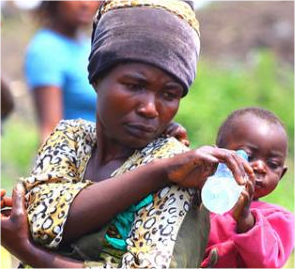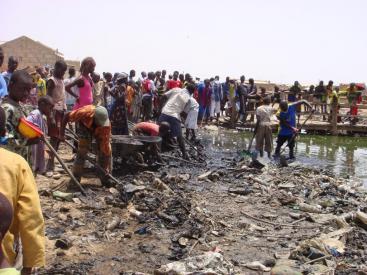Difference between revisions of "SS - Introduction"
(→Acknowledgements) |
|||
| (3 intermediate revisions by the same user not shown) | |||
| Line 1: | Line 1: | ||
| + | {{Language-box|english_link=SS - Introduction|french_link=Durabilité sociale - Introduction|spanish_link=coming soon|hindi_link=coming soon|malayalam_link=coming soon|tamil_link=coming soon | korean_link=coming soon | chinese_link=coming soon | indonesian_link=Coming soon | japanese_link=Coming soon}} | ||
[[File:Social sust.png|thumb|right|200px|Photo credit: coming soon]] | [[File:Social sust.png|thumb|right|200px|Photo credit: coming soon]] | ||
| Line 26: | Line 27: | ||
The cultural context of the users may act as an enabling factor or as a counteracting force for good water management. By assessing cultural backgrounds of the users, one can raise ownership and increase the potential of success, or, on the other hand, mitigate risks of failure. Failure could mean that systems are not used, or worse, are sabotaged. To consider beliefs and traditional practices becomes even more evident when promoting the treatment of excreta for further use, as claimed by sustainable sanitation and IWRM concepts. Different groups of people have varying, culturally determined relations to human excreta, which affect the acceptance of their treatment. | The cultural context of the users may act as an enabling factor or as a counteracting force for good water management. By assessing cultural backgrounds of the users, one can raise ownership and increase the potential of success, or, on the other hand, mitigate risks of failure. Failure could mean that systems are not used, or worse, are sabotaged. To consider beliefs and traditional practices becomes even more evident when promoting the treatment of excreta for further use, as claimed by sustainable sanitation and IWRM concepts. Different groups of people have varying, culturally determined relations to human excreta, which affect the acceptance of their treatment. | ||
| + | |||
| + | ===Links=== | ||
| + | * [http://www.pseau.org/outils/biblio/index.php?d=2756&l=fr&vue_pgm_o_tout=1&motclef%5B%5D=129&tri1=titre Affiches de sensibilisation Hygiène et Assainissement de Tessaoua] | ||
=== Acknowledgements === | === Acknowledgements === | ||
| − | *[http://www.washalliance.nl/ | + | *[http://www.washalliance.nl/?s=social+sustainability&x=0&y=0 FIETS sustainability]. Dutch WASH Alliance. |
*Risch Tratschin, [http://www.sswm.info/category/background/background/background/socio-cultural-issues/water-sanitation-and-culture Water, Sanitation and Culture]. SSWM. | *Risch Tratschin, [http://www.sswm.info/category/background/background/background/socio-cultural-issues/water-sanitation-and-culture Water, Sanitation and Culture]. SSWM. | ||
__NOTOC__ <small-title /> | __NOTOC__ <small-title /> | ||
Latest revision as of 01:41, 2 June 2015
| |
|
|
|
|
|
|
|
|
Social sustainability brings great awareness and help to the disenfranchised minorities (poor women, children, certain ethnic groups, etc.) of society that do not receive adequate funding or implementation for water and sanitation systems.
A socially sustainable solution is one that is equitable, inclusive and democratic and considers the quality of life for current and future generations. Social sustainability also considers cultural beliefs or traditions that can be respected or dealt with positively to ensure social acceptance of a water and sanitation system.
Social sustainability will contribute to WASH interventions that are sustainable by ensuring that:
- Interventions are based on real demand as these will be well embedded in the society, people participate and will feel listened to, leading to a feeling of ownership towards the provided service, leading to a proactive attitude towards solving the demand and keeping it solved.
- Interventions are fully inclusive for all groups in society (equity) as that will ensure that all groups will benefit and advance in development thereby lessening the potential for internal conflicts.
- Interventions are based on strategies that are sensitive to local and cultural incentives, as these will be adopted by the society more easily, people can relate to the chosen strategy more easily and are more open to changes if these are based on a positive attitude towards local and cultural practices and behaviours.
- Interventions are needs-based so solving WASH problems in societies, groups and geographic areas where relatively higher need exists compared to other societies, groups or geographic areas.
Focus on women
Women and girls are powerful change agents. Investing in women has a high leverage rate, because they are known to be responsible credit takers. They are also the ones that suffer most from the lack of water and sanitation facilities, because of their traditional role as caretakers.
To empower them is to bring about change within a household, and a community. They are for instance responsible for the task of fetching water. Women have to care for the household and also for their children. A water point nearby the house and a latrine with privacy are direct improvements for the livelihood of women and children: less time spent fetching water; less exposure to physically and sexually dangerous situations; more time for attending school or earning activities.
Importance of social acceptability of water and sanitation systems or programs
Any relations between people and their environment are embedded in culture. More precise, any choices and behaviours related to water and sanitation are deeply rooted in a cultural context. To deal with excreta might often be taboo or water might be connected to beliefs and traditions. Therefore, the respect for, assessment and integration of the cultural context of users such as religious or cultural beliefs, gender or generational differences in water and sanitation programmes are crucial to mitigate failure risks and promote sustainable solutions.
Among experts, the impact of societal and cultural aspects related to the use and the reuse of water and to human excreta is unquestioned. Technical concepts imported to another region without considering the cultural context have too often caused failure. Local beliefs, traditions and practices, but also gender and generational differences have hence become a decisive factor in planning and operating of water and sanitation.
The cultural context of the users may act as an enabling factor or as a counteracting force for good water management. By assessing cultural backgrounds of the users, one can raise ownership and increase the potential of success, or, on the other hand, mitigate risks of failure. Failure could mean that systems are not used, or worse, are sabotaged. To consider beliefs and traditional practices becomes even more evident when promoting the treatment of excreta for further use, as claimed by sustainable sanitation and IWRM concepts. Different groups of people have varying, culturally determined relations to human excreta, which affect the acceptance of their treatment.
Links
Acknowledgements
- FIETS sustainability. Dutch WASH Alliance.
- Risch Tratschin, Water, Sanitation and Culture. SSWM.


